![]()
![]()
![]()
Use LEFT and RIGHT arrow keys to navigate between flashcards;
Use UP and DOWN arrow keys to flip the card;
H to show hint;
A reads text to speech;
22 Cards in this Set
- Front
- Back

CONDITIONING |
A process of learning associations between a stimulus in the environment (one event) and a behavioural response (another event). For example, associating a smile with friendly behaviour.
There are two main type of conditioning: classical conditioning and operant conditioning. |
|
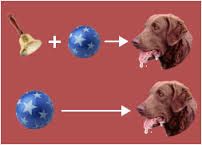
CLASSICAL CONDITIONING |
Classical conditioning is a type of learning that occurs when there is a repeated association of two (or more) different stimuli.
Learning is only said to have occured when a particular stimulus consistently produces a response that it did not previously produce.
A stimulus is any object or event that produces a response from an organism.
A response is a reaction by an organism to a stimulus. |
|
|
KEY ELEMENTS OF CLASSICAL CONDITIONING |
Four key elements are used to describe the process of classical conditioning:
Unconditioned stimulus (UCS) - a stimulus that consistently produces a particular, naturally occuring, automatic response. For example, a UCS is the mother's nipple and the response is the infant's automatic sucking reflex.
Unconditioned response (UCR) - the response that occurs automatically when the UCS is presented.
Conditioned stimulus (CS) - the stimulus that is 'neutral" at the start of the conditioning process and does not normally reproduce the unconditioned response. However when there is repeated association with the UCS, the Cs triggers a very similar response to the one caused by the UCS.
Conditioned response (CR) - is the learned response that is produced by the CS. It occurs after the CS has been connected with the UCS.
Neutral stimulus - anything that does not normally produce a predictable response. For example, the bell at the start of Pavlov's experiment was neutral. |
|
|
PAVLOV'S EXPERIMENT (CLASSICAL CONDITIONING) |
After Pavlov observed that his dog became to salivate whenever it saw the lab technician, he began an investigation into why the dog does that. He found in his experiment that the dog learned this behaviour.
In his experiment he presented the bell (NS) which produced no response and then followed it with food (UCS) which caused the dog to salivate (UCR). He repeated this sequence of actions until the bell became a CS so when the bell was presented only and not the food, the dog started to salivate (CR) because it associated the bell with the action that it was going to get fed. |
|
|
KEY PROCESSES IN CLASSICAL CONDITIONING |
Acquisition - an overall process during which an organism learns to associate two events (CS and the UCS). In this time the CS and UCS occur in time close together and in the same sequence.
Extinction - the gradual decrease in the strength or rate of a CR that occurs when the UCS is no longer presented. It occurs after the CR is no longer activated following the presentation of the CS.
Spontaneous recovery - is the reappearance of a CR when the CS is presented, following a rest period after the CR appears to have been extinguished. This doesn't always happen and is often short-lived.
Stimulus generalisation - is the tendency for another stimulus that is similar to the original CS to produce a response that is similar to the CR.
Stimulus discrimination - occurs when a person or animal responds to the CS only, but not to any other stimulus that is similar to the CS. (opposite to stimulus generalisation) |
|
|
APPLICATIONS OF CLASSICAL CONDITIONING |
conditioned emotional response - an emotional reaction that usually occurs when the autonomic nervous system produces a response to a stimulus that did not previously trigger that response.
Watson 'Little Albert' experiment - |
|

WATSON'S 'LITTLE ALBERT' EXPERIMENT |
John B Watson and his graduate student Rosalie Rayner desgined an experiment to test the belief that fears can be acquired through classical conditioning.
Their research participant "Little Albert" was an 11 month old son of a woman who worked at the same clinic as Watson.
According to Watson, Little Albert showed great emotional stability as he never showed fear or rage so these experiments would cause little harm to him.
They placed him on a mattress where a white labatory rat (CS) was within reaching distance. He showed no initial fear and was playing with the rat happily. As this was happening, an experimenter distracted him while the other experimenter stood behind Albert and struck a hammer upon a suspended steel bar.
This produced a loud noise (UCS) that would startle most people regardless of what they were doing. Albert was startled violently and his breathing became rapid. On the second stimulation, he began to tremble and on the third, he broke into a sudden crying fit.
These experiments were held over 17 days. Whenever he tried to touch the rat, the bar was struck behind Albert. Through this he developed a fear response. So whenever he saw the rat, he instantly started crying then tried to crawl away rapidly.
They continued experimenting to see if his fear response could be generalised to other stimuli. He produced fearful reactions to a white, rabbit, a dog, and a sealskin coat.
Eventually Albert's mother left her job and the city in which the experiments were conducted. Even though the experimenters knew in advance that the mother was leaving they made no attempts to extinguish Albert's fear response which is unethical. It also seems that informed consent and withdrawal rights were not in use.
From this, Albert was emotionally traumatised and would have most likely obtained some longlasting psychological harm.
He died at the age of 6 from a brain disease which contradicts Watson's statement that Albert was a "stable" baby. |
|

GRADUATED EXPOSURE |
It involves presenting successive approximations of the CS until the CS itself does not produce the conditioned response.
It desensitises the person from their fear by gradually exposing them to similar stimuli which would produce the the conditioned response and eventually exposing them to the CS itself.
For example someone afraid of flights would have a least of what they found the most frightening to the least frightening. From this list, a therapist would help the person overcome their fears at their own pace by imagining the situation (imaginal exposure) or real-life exposure (in vivo exposure). As the client confronts their fears in a supportive circumstances, the client learns to tolerate thesse fearful situations and eventually overcome those fears. |
|
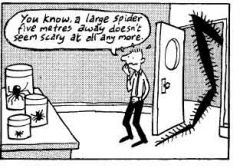
FLOODING |
Another type of exposure therapy in which it involves bringing the client into direct contact with the anxiety or fear-producing stimulus and keeping them in contact with it until the conditioned response is extinguished.
This contact can be for 2 hours or longer. Essentially a person will stop associating fear with the stimulus when they are exposed to it directly and realise that it is actually harmless. Exposure can be conducted with visual imagery or in vivo (real life) or using a virtual reality device. |
|
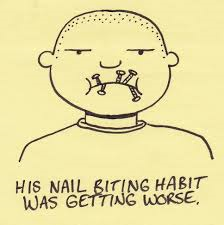
AVERSION THERAPY |
A form of behaviour therapy that applies classical conditioning processes to inhibit (block) or discourage undesirable behaviour by associating it with an aversive (unpleasant) stimulus such as a feeling of disgust, pain or nausea.
For example to stop an unwanted behaviour such as biting your fingernails, your fingernail could be painted with a foul tasting substance. In which you will associate nail biting with an unpleasant taste thus stopping that behaviour. |
|
|
TRIAL AND ERROR LEARNING |
Involves learning by trying alternative possibilities until the desired outcome is achieved.
It is a simple way of learning to adjust to the environment and deal with everyday challenges.
It involves: Motivation - a desire to attain some goal. Exploration - an increase in activity, either purposeful or random. Responses- whether they are incorrect or correct. Reward - the correct response is made and rewarded.
For example, when learning to play tennis, you can make a lot of mistakes when serving and hitting the ball but through trail and error you begin to make fewer mistakes and master the required actions.
|
|
|
OPERANT CONDITIONING |
Also called instrumental conditioning, is a type of learning whereby the consequences of an action determine the likelihood that it will be performed again in the future.
More specifically it states that an organism will tend to repeat an behaviour that has desirable consequences or avoid behaviour that has undesirable consequences.
An operant is any response (or set of responses) that acts (operates) on the environment to produce some kind of consequence. They are voluntary. |
|
|
THREE-PHASE MODEL OF OPERANT CONDITIONING |
It has three parts that occur in a specific sequence.
1. The discriminative stimulus (S^D) - is the stimulus that precedes a particular response, signals the probable consequence for the response and thus influences the occurence of the response. (antecedents thing that occurs right before the behaviour)
2. The response - is voluntary behaviour that occurs in the presence of the discriminative stimulus which can either be one action or a set of actions.
3. The consequence - is the environmental event that occurs immediately after the response and determines whether or not the reponse will occur.
These steps have an effect on future behaviour in whether it will occur more or less often and how frequently the behaviour will occur.
For example you see a soft-drink vending machine (discriminative stimulus) and place $2 (response) in which you then lose money and get no soft drink (consequence). This is a form of punishment that will make you less likely to use a vending machine in the future. |
|
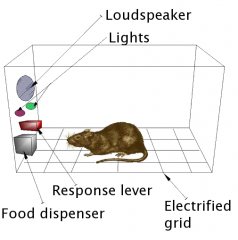
SKINNER'S EXPERIMENT WITH RATS |
He created a Skinner box which is a small chamber in which an experimental animal learns to make a particular response for which the consequences can be controlled by the researcher.
It contains a lever that delivers food into a dish when pressed. There was also an electrified grid floor that delivered a mild electric shock. The lever is connected to a recorder that indicates the frequency of the response and the speed of the response.
He demonstrated operant conditioning by placing a hungry rat in the box. It eventually by chance pressed a lever mounted on the wall. Immediately a pellet of rat food dropped into the food dish which the rat than ate. With additional repetitions of lever-pressing followed by food, the rat's random movements began to disappear and were replaced by more consistent lever pressing.
The rat, through operant conditioning learnt that the lever led to food which was the reward. He intentionally used hungry rats as their motivation of hunger would cause them to respond in the desired way. He believed that only environmental factors influenced behaviour and not internal mental factors so he did not bother to find them in his experiment. |
|
|
ELEMENTS OF OPERANT CONDITIONING |
Reinforcement - is said to occur when a stimulus strengthens or increases the frequency or likelihood of a response that it follows. -A reinforcer is any stimulus that strengthens or increases the frequency or likelihood of a response that it follows. -Positive reinforcer- a stimulus that strengthens or increases the frequency or likelihood of a desired response by providing a satisfying consequence. Positive reinforecement strengthens an action after the stimulus is given. -Negative reinforcer - is any unpleasant or aversive stimulus that, when removed or avoided, strengthens or increases the likelihood of a desired response. Negative reinforcement is the removal or avoidance of an unpleasant stimulus.
PUNISHMENT - is the delivery of an unpleasant consequence following a response, or the removal of a pleasant consequence following a response. Punishment is given and negative reinforcement is prevented or avoided. -Postive punishment involves the presentation of a stimulus and thereby decreasing the likelihood of a response occuring again. -Negative punishment involves the removal or loss of a stimulus and thereby decreasing the likelihood of a response occuring again. -Response cost is described as involving removal of any valued stimulus , whether or not it causes the behaviour. Factors that influence the effectiveness of reinforcement and punishment -Order of presentation - reinforcement and punishment need to be presented after a desired response, never before for operant conditioning to take place. -Timing - it is more effective if reinforcement and punishment are given immediately after the response. -Appropiateness - The reinforce needs to be appropiate enough that it strengthens the behaviour in the individual.
SCHEDULES OF REINFORCEMENT - a program for giving reinforcement: specifically the frequency and manner in which a desired response is reinforced. -Continuous reinforcement - When the reinforcer is typically provided immediately after every correct response after it occurs. -Partial reinforcement - is the process of reinforcing some correct responses but not all of them. There are four basic schedules of partial reinforcement. -Fixed-ratio schedule - when the reinforcer is given after a set, unvarying number of desired responses have been made. -Variable-ratio schedule - is when the reinforcer is given after an unpredictable number of correct responses. -Fixed-interval schedule - involves delivery of the reinforcer after a specific time has passed since the previous reinforcer, provided the correct response has been made. -Variable-interval schedule - is when reinforcement is given after irregular periods have passed, provided the correct response has been made.
|
|
|
KEY PROCESSES IN OPERANT CONDITIONING |
Acquisition - it is the establishment of a response through reinforcement.
Extinction - is the gradual decrease in the strength or rate of a conditioned (learned) response following consistent non-reinforcement of the response.
Spontaneous recovery - can occur and the organism will once again show the response in the absence of any reinforcement.
Stimulus generalisation - occurs when the correct response is made to another stimulus that is similar to the stimulus that was present when the conditioned response was reinforced.
Stimulus discrimination - occurs when an organism makes the correct response to a stimulus and is reinforced, but does not respond to any other stimulus, even when stimuli are similar. |
|
|
APPLICATIONS OF OPERANT CONDITIONING |
Shaping - (method of successive approximations)a procedure in which a reinforcer is given for any response that successively approximates and ultimately leads to the final desired response, or target behaviour. So in Skinner's experiment, shaping is evident when he taught the pigeon to turn left a full circle. He began by rewarding the pigeon with a food pellet when it turned a little bit to the left. When it learnt that response, he stopped reinforcing the pigeon until it turned left some more, eventually shaping the pigeon to regularly turn full circles.
Token economy - is a setting in which an individual receives tokens (reinforcers) for desired behaviour. These tokens can then be collected and exchanged for other reinforcers in the form of actual rewards. For example in a school, if students complete assignments on time then they receive a token in which they can cash in for rewards such as snacks. |
|
|
COMPARING CLASSICAL AND OPERANT CONDITIONING |
Similarities - They both have acquisition in which a response is conditioned or learned. Also extinction of the learned response can occur which means that spontaneous recovery can also occur.
Differences - In classical conditioning the response is involuntary but in operant conditioning the response is voluntary.
The role of the learner - In classical conditioning, the learner is a passive participant as they do not need to do anything for the CS or UCS to be presented. Also the response made by the learner is automatic so the learner has no control over the conditioning process. In operant conditioning, the learner is an active participant as they must operate on the environment before reinforcement or punishment is received. The learner does not experience reinforcement or punishment if they have not performed the response that produces the consequence so the learner does have control over the learning process.
Timing of the stimulus and response - In classical conditioning, the response depends on the presentation of the UCS occuring first. In operant conditioning, the presentation of the reinforcer or punisher depends on the response occuring first. In classical conditioning, the timing between the UCS and CS needs to be immediate for it to be effective whereas in operant conditioning the response and the reinforcement/punishment can have a considerable time difference between and effective learning will still occur.
The nature of the response - In classical conditioning, the response by the learner is usually a reflexive involuntary behaviour that is involved by the action of the autonomic nervous system. In operant conditioning, the response by the learner is usually voluntary behaviour and can involve the autonomic nervous system but mostly involves the CNS (the brain) and is intentional/goal directed. |
|
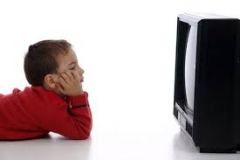
OBSERVATIONAL LEARNING |
It occurs when someone uses observation of a model's actions and the consequences of those actions to guide their future actions. |
|
|
SOCIAL LEARNING THEORY |
This theory emphasises the importance of the environment, or 'social context', in which learning occurs.
His model shows that both classical and operant conditioning can occur vicariously through observational learning.
Vicarious conditioning - The individual watches a model's behaviour being either reinforced or punished, and then subsequently behaves in the same way or in a modified way, or refrains from the behaviour.
Vicarious reinforcement - increases the likelihood of the observer behaving in a similar way to a model whose behaviour is reinforced. (Thus the observer is conditioned by watching without personally experiencing the consequence directly.)
Vicarious punishment - occurs when the likelihood of an observer performing a particular behaviour decreases after having seen a model's behaviour being punished. |
|

BANDURA'S EXPERIMENT WITH CHILDREN |
Bandura was interested in observational learning of aggression so he conducted an experiment in which pre-schoolers were required to passively sit and watch a model engaging in aggressive behaviour and then given the opportunity to imitate the model's behaviour.
Bobo doll experiment - He used four year old pre-schoolers as participants in which they were allocated to one of three groups with equal number of boys and girls and watched one of three movies. Each movie showed an adult model punching, hitting, kicking and verbally abusing a large air-inflated Bobo doll.
The differences in the movie was that in condition 1: aggressive model was rewarded with soft drinks and lollies and praise by another adult. condition 2: aggressive model was punished with a spanking an verbal criticisms by another adult. condition 3: there were no consequences for the aggressor's behaviour.
After they watched the movie each child was placed individually in a room that had many toys and a Bobo doll. The child's behaviour was observed through a one way mirror. For some pre-schoolers they were offered stickers, fruit juice and praise for imitating the model's behaviour while others weren't.
The results showed that the consequences for the model's behaviour influenced the behaviour displayed by the children. the children behaved more aggressively when they were offered a reward even if they watched the adult being punished. Even though the boys were more aggressive than the girls in all of the conditions, the girls were nearly as aggressive when offered a reward.
In some cases children did not perform aggressive behaviour at all until an incentive was offered so this shows the model's behaviour was acquired cognitively and processed and can be elicited with an appropriate reinforcer so they have formed cognitive representations of what they have observed. |
|
|
OBSERVATIONAL LEARNING PROCESSES |
Attention - If we are to learn through observation we must closely watch a model's behaviour and consequences. Attention is influenced by several factors which include: perceptual capabilities of the observer, motivation and interest level, situation in which behaviour is being observed, distracters that are present, characteristics of the model such as attractiveness. According to Bandura we are more likely to imitate models who: are perceived positively, perceived similarities between model and observer, model is familiar to the observer, model stands out from others.
Retention - Retaining a cognitive representation of the model's behaviour until they imitate it.
Reproduction - Having the ability to reproduce what they observed.
Motivation - If it is useful or provides an incentive for the observer they are more likely to perform the behaviour.
Reinforcement - influences the motivation to reproduce the observed behaviour. ~External reinforcement - is comparable to learning by consequences, for example if you get paid for your job you are more likely to become more skilled at your craft. ~Vicarious reinforcement - occurs indirectly by observing the modelled behaviour being reinforced without personally experiencing the reinforcement. ~self-reinforcement - occurs when we are reinforced by meeting certain standards of performance we set for ourselves. |

